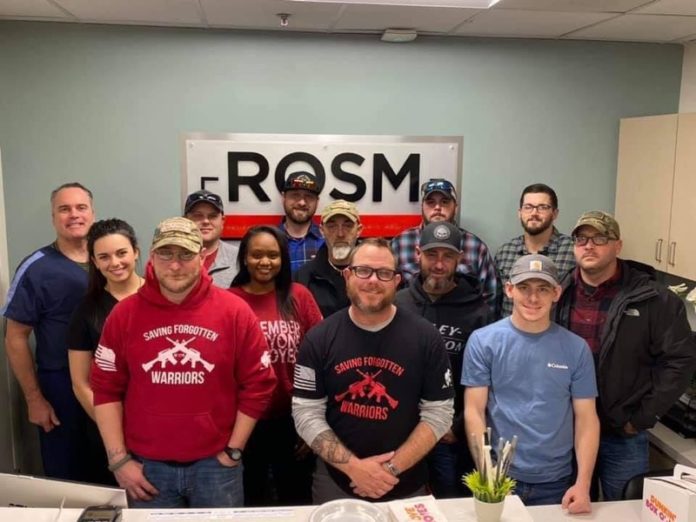
CORRECTION- 3-11-20 at 6:55 p.m.
In The Tribune’s coverage of the stellate ganglion block (SGB) shot, we have said, “The SGB shot is FDA-approved.” In fact, the medications administered through the shot are FDA-approved. The shot itself does not require FDA approval.
CULLMAN, Ala. – Late last year, local Vietnam veteran and veterans advocate, retired Col. Ken Brown, sat down with The Tribune to talk about a sobering statistic: every day, 22 veterans commit suicide in the United States. Brown wanted to talk about a new treatment for post-traumatic stress disorder (PTSD) that aims to reverse that trend, the stellate ganglion block (SGB) shot. Local nonprofit Saving Forgotten Warriors (SFW) officially launched the local effort, the “800 Club,” Dec. 12, 2019, with a $12,000 donation from Apel Steel. Now, less than three months later, 10 local veterans have received the treatment, with all reporting dramatic success.
Recently, Brown was thrilled to report, “We had 10 guys that went, and we had 10 guys that came home, and it was successful. The effort is paying off.”
The SGB shot is now being given at military hospitals, but the procedure has not yet been made available to VA hospitals around the country.
“It is a shot in the neck that relaxes the nerves, the stellate ganglion nerves, that, in layman’s terms, ‘reboots’ the nervous system,” Brown said in December. “There’s been a three-year study on it, and it’s been 90% effective. The shots last five years or more, and the results are almost instantaneous. PTSD is a debilitating disease, not only to the veterans who have it, but also to their families who go through it. A lot of veterans can’t handle PTSD and commit suicide.”
The 800 Club
“There’s a former Navy SEAL doctor (Dr. Sean Mulvaney) in Annapolis, who is offering these shots now for $800. They normally cost between $1,500 and $3,000 a shot elsewhere,” said Brown in a previous interview. “He is the closest one we’ve found to Cullman. We have 7,000 veterans in Cullman County, and a bunch of them have PTSD. So the objective is to get the word out and have them get in touch with (founder) Jeremy Hogan at Saving Forgotten Warriors, and he will line them up to go get the shot in Maryland.”
SFW is aiming to fly multiple veterans suffering from PTSD per year to Maryland to receive the shot. SFW’s 800 Club, named such because the cost of the shot is $800 per veteran, was formed late last year. With the first group of veterans having now received the shot and reporting excellent results, SFW is reaching out to the community for support. The group is asking individuals, churches and businesses to donate any amount possible in order to help.
SFW’s next trip to Maryland will be April 23, with 14 veterans making the voyage.
Local success
One of the 10 veterans to receive the shot through SFW this year shared a little about his experience. He preferred to remain anonymous, giving only his initials, R.K.
“Every morning,” he began, “I won’t say I was suicidal, but it was on my brain. The first thing, wake up, feet hit the ground in the morning, that was the first thing across my head. Now it’s been, today marks one week exactly since I’ve had the shot, and it hasn’t crossed my mind at all. Last night- I’ve always been kind of a light sleeper- and last night, I actually for the first time in probably 15 years, slept through the night, actually overslept my alarm.”
R.K. served two tours in Afghanistan, from 2003-2004 and 2005-2006.
“Last year, during Christmas, I went into a store with my family and I was actually looking at some stuff and then actually noticed the crowd start pouring into the store. As soon as I turned around, there was that spark- there I am middle of store, crowded, completely packed, 100, 150 people in the store. All I had was the back corner of the room. My wife actually had to take me out of there and drive me all the way all the way back home so I could take my Ativan, lorazepam, all that stuff. I had to leave my kids with my in-laws so they could enjoy the Christmas parade. This had been a habitual problem.”
Said Hogan, “I hand-picked the first 10 to go, the ones that I have been working with for years. They have different issues, and they’re not all the same, but they all had post-traumatic stress and they were all suicidal. Not all of them were attempting, but they were dealing with suicidal ideation every day.”
He continued, “This is not a cure. It is a tool to get you where you need to be and gives you the best opportunity to recover.”
Hogan said R.K. was one of his most in-need veterans.
“This guy, this guy here,” he said, motioning to R.K., who is now full of smiles, “every time I’d see him he was flushed. He had a flushed look on his face.”
Said R.K., “My eyes were sunken, black underneath from lack of sleep, lack of outdoors.”
“He had been just going through the motions of the day, not living,” said Hogan.
“Since ’06,” R.K. said.
“That demon had been on his back every single day since ’06,” said Hogan. “Since Feb. 20 when he got the shot, he’s finally home. We got him to ‘come home.’ That’s huge. That’s what we want.”
More about the SGB shot
“The stellate ganglion is like a routing center for the nervous system and controls the impulse for ‘fight or flight’,” said a statement from Kristine Rae Olmsted, a research epidemiologist with RTI International, an independent nonprofit research institute. “Anesthetizing the ganglion blocks nerve impulses temporarily. We still don’t know how SGB works to improve PTSD symptoms, but now we know that it does.”
According to RTI International: “In the early 2010s, some military medical centers began offering patients with PTSD a procedure that had been used for decades to relieve pain. The procedure, called stellate ganglion block, or SGB, involves injecting a local anesthetic into the stellate ganglion. This group of nerve cells and nerves in the neck helps regulate the body’s ‘fight or flight’ mechanism. As more and more patients tried the stellate ganglion block, the reports seemed promising. But the medical community still needed evidence of its effectiveness. RTI in 2014 launched a randomized, controlled trial of SGB, and in fall 2019, we found that it is indeed effective.”
You can read the study here: https://jamanetwork.com/journals/jamapsychiatry/article-abstract/2753810.
How to donate or get help
SFW is a 501(c)(3) nonprofit, and any donation is tax-deductible. Donations can be mailed to P.O. Box 1002, Cullman, AL 35056. If you, or someone you know, is a veteran in need, contact SFW at 256-747-5006. Veterans in crisis can also text “888” to Hogan directly at any time at 256-347-2001. Find out more at www.savingforgottenwarriors.com.
Copyright 2020 Humble Roots, LLC. All Rights Reserved.





















